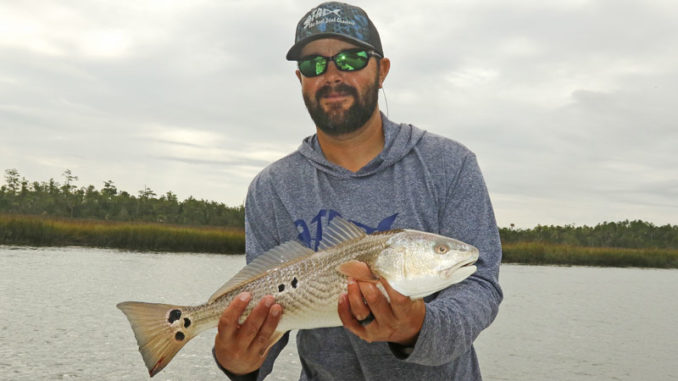
Brackish, coastal rivers can be havens for redfish, other mixed species
Tidal rivers are some of the most underfished areas across the Carolinas when it comes to targeting redfish — at least their upper reaches. But these areas have everything redfish need to thrive, and because they are so underutilized, anglers can have fish all to themselves.
November is a great time to explore these areas. Rivers are often narrow waterways with trees lining the banks, protecting anglers at least somewhat from the wind. And while the water level rises and falls with the tides, these areas are much calmer, for the most part, than even a skinny, inshore creek. No one likes to get wet this month. And that’s usually not a problem in upper reaches of these rivers.
To the naked eye, these areas can look like freshwater hotspots for largemouth bass. Downed timber is abundant, thanks to saltwater influx killing trees that grow for years with minimum resources, only to die of eventual salt poisoning when they’re the perfect size for fish to hide around to ambush prey. Anglers don’t hear crashing surf, furthering the feel of a freshwater environment.
If you blindfolded a man before dropping him into these locales, he’d be hard pressed to know what part of the state he was in. He’d figure it out once the tide starts rolling in, reversing the current temporarily.
Redfish habitat
Redfish love these areas. The water is typically fairly shallow and holds a steadier temperature than water closer to the open ocean. Brackish is fine with redfish. They can tolerate very low levels of salinity for extended periods of time.
And they find plenty to eat. Small saltwater and freshwater fish, turtles, crabs and shrimp live in these areas. And as the temperature continues to drop, many of them slow down, conserving energy, sticking close to structure and moving as little as possible. They’re sitting ducks for redfish, which thrive in the cooler waters of November.
Anglers can either soak bait on the bottom or take a more-active role. Many drop their trolling motors and cruise up and down the banks, pitching lures at targets just like bass anglers do. It’s a good strategy, allowing you to cover lots of water relatively quickly and catch plenty of redfish.
Brackish lures
Spinnerbaits like Strike King’s Redfish Magic or the Z-Man BullZEye spinnerbait are tough to beat. These bladed lures are easy to cast. And although they have exposed hooks, their designs allow them to bounce off of structure with far fewer hangups than you might expect.
Proficient anglers can skip them under fallen timber. But casting and retrieving them parallel to those structures is also deadly, keeping the lure in the strike zone much longer.
Fishing soft-plastic shrimp under a popping cork is also a very effective tactic. In small, inshore creeks, these are great for casting toward the bank, then working back to the boat. That works in coastal rivers, too. But just like spinnerbaits, these are especially effective when cast parallel to a downed, half-sunken tree. The strike zone runs the entire length of such a tree. A swift pop of the cork often finds the lure below greeted with a violent strike from an aggressive redfish.
These areas look ripe for topwater lures, but they are less effective for redfish, which have downturned mouths, making it difficult for them to bite surface objects. But depending on recent rainfall amounts, these lures could catch speckled trout or largemouth bass.
Bonus species
That’s another great thing about fishing in the upper reaches of tidal rivers. Because redfish can tolerate either heavy salinity or light salt, the ones that take up home in these areas will stay put when rain — or the lack thereof — runs other species away.
Long periods of rain bring freshwater pouring into these areas, dropping salinity levels enough that speckled trout and baitfish head toward to the ocean. Typically, in inshore creeks, redfish will also leave because they chase the bait. But in these upper reaches, the heavy influx of freshwater brings largemouth bass, bream, crappie and baitfish from upriver. So redfish stay and enjoy some new menu items.
That dynamic offers anglers a steady supply of redfish, as well as an ever-changing selection of bonus fish. Some anglers even talk of the lower half of the water column being filled with saltwater fish and the upper half full of freshwater fish, with redfish intermingling with both. On rivers with striper populations, this adds another predator species that’s a blast to catch.
Give fishing these upper reaches of tidal rivers a try this month, especially on days with less than ideal weather that can make inshore fishing less pleasant. You just might find your new hotspot and have it all to yourself.



Be the first to comment